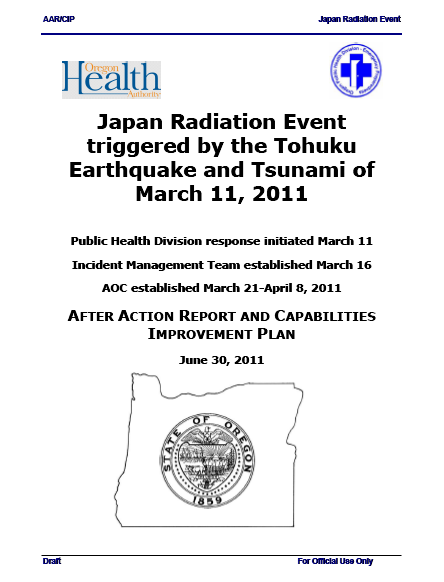The following report was obtained from the website of the Pacific Northwest Border Health Alliance.
Oregon Health Authority and Public Health Division
- 45 pages
- For Official Use Only
- June 30, 2011
A 9.0 earthquake occurred at 14:46 local (Japan) time [05:46 hours GMT1 on Friday, March 11 off of the NE coast of Japan. This equates to 21:46 hours Pacific Time on Thursday. March 10. The resulting tsunami (along with earthquake damage) devastated the NE Japan coastline, sent a tsunami across the Pacific and caused severe damage to the nuclear reactors at the Fukushinia Daiichi Nuclear Plant. 127 miles NP of’ Tokyo. The tsunami alert by the Pacific Tsunami Warning Center resulted in evacuation orders being issued for coastal Oregon communities, with the only significant tsunami damage in Oregon occurring in Curry County at Brookings. Once it became clear that the tsunami would not have widespread impact in Oregon, the next issue of concern was the potential impact in Oregon of the radiation release from the damaged nuclear reactors. A determination was made between Oregon Emergency Management and state Public Health that Public Health would take the lead in addressing public concerns about radiation and OEM would assume the lead in the Tsunami response and recovery effort.
The Public Health Duty Officer was initially notified of the Earthquake & Tsunami at 0300, Friday 11 March, Oregon Public health Division (OPHD) leadership considered the appropriate roles and response for the agency during the day, with Dr. Mel Kohn, State Public Health Director, issuing his first public statement on the health implications for Oregonians from the radiation release in Japan on Saturday 12 March. The Office of Environmental Public Health and its Radiation Protection Services (RPS) initially assumed the lead in response efforts to the event. It soon became clear that the complexity of the response (communications with the public, communications and coordination with intra and inter-state partners and working with Federal agencies), required a more robust response. A modified Incident Management Team (IMT) was subsequently formed on 16 March and a limited Agency Operations Center (AOC) activation occurred on Monday, 21 March.
…
The Oregon response to the Japan Radiation Event was a real-time response triggered by the Tohuku Earthquake and Tsunami of March 11, 2011. Damage caused by the tsunami to the Oregon coast did not necessitate a state Public Health response. Rather, state PH focused primarily on the health and medical informational needs of the public, public health and medical partners and other state agencies and tribes.
OPHD initially responded in an ad hoc manner. It was subsequently determined that a more effective approach would be to establish an Incident Management Team and activate the Agency Operations Center, which were accomplished on 16 March and 21 March respectively.
Agency Operations Center and Public Health Information Center operations worked well, with enhanced cooperation demonstrated in message development and interaction with the media. Use of HAN, links on the OHA website to FAQs and statistical data, rapid translation of messages into 6 languages, teleconferences with LHDs, tribes, PIOs and Region X Federal and state partners and Oregon Emergency Management facilitated calls with sister state agencies resulted in consistent information being provided. The major deficiency in the process was the lack of clarity and responsiveness from the national headquarters of federal agencies (EPA, FDA).
‘Though circumstantial (LHDs and other state partners were surveyed, not the general public) SurveyMonkey results suggest that the state’s Japan Radiation Event responsive was effective in providing the necessary information to both inform and calm the public’s concerns.

